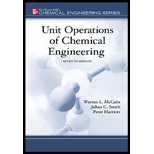
Interpretation:
The given motor power is to be verified to be adequate to drive the agitator at the given speed.
Concept Introduction:
The formula to calculate the Reynolds number for an agitator is:
Here,
Now, power consumption by the agitator is calculated as:
Here,
Answer to Problem 9.1P
The given motor with 8 kW power is not adequate to drive the agitator at the required speed as the power required is more than the available power of the motor.
Explanation of Solution
Given information:
Tank diameter,
Height of the tank,
Depth of latex filled in the tank,
Viscosity of latex,
Density of latex,
The tank is not baffled.
Diameter of the propeller,
Height of the propeller in the tank,
Pitch is 1:1
Agitator speed,
Three-blade propeller is used.
Available power from the motor,
Convert the speed of the propeller from r/min to r/s as:
Use equation (1) to calculate the Reynolds number for the propeller as:
From the plot of
Use equation (2) to calculate the required power for the given agitator as:
Since the required power is more than the available power, the motor available to drive the agitator is not adequate.
Want to see more full solutions like this?
Chapter 9 Solutions
Unit Operations of Chemical Engineering
 Introduction to Chemical Engineering Thermodynami...Chemical EngineeringISBN:9781259696527Author:J.M. Smith Termodinamica en ingenieria quimica, Hendrick C Van Ness, Michael Abbott, Mark SwihartPublisher:McGraw-Hill Education
Introduction to Chemical Engineering Thermodynami...Chemical EngineeringISBN:9781259696527Author:J.M. Smith Termodinamica en ingenieria quimica, Hendrick C Van Ness, Michael Abbott, Mark SwihartPublisher:McGraw-Hill Education Elementary Principles of Chemical Processes, Bind...Chemical EngineeringISBN:9781118431221Author:Richard M. Felder, Ronald W. Rousseau, Lisa G. BullardPublisher:WILEY
Elementary Principles of Chemical Processes, Bind...Chemical EngineeringISBN:9781118431221Author:Richard M. Felder, Ronald W. Rousseau, Lisa G. BullardPublisher:WILEY Elements of Chemical Reaction Engineering (5th Ed...Chemical EngineeringISBN:9780133887518Author:H. Scott FoglerPublisher:Prentice Hall
Elements of Chemical Reaction Engineering (5th Ed...Chemical EngineeringISBN:9780133887518Author:H. Scott FoglerPublisher:Prentice Hall
 Industrial Plastics: Theory and ApplicationsChemical EngineeringISBN:9781285061238Author:Lokensgard, ErikPublisher:Delmar Cengage Learning
Industrial Plastics: Theory and ApplicationsChemical EngineeringISBN:9781285061238Author:Lokensgard, ErikPublisher:Delmar Cengage Learning Unit Operations of Chemical EngineeringChemical EngineeringISBN:9780072848236Author:Warren McCabe, Julian C. Smith, Peter HarriottPublisher:McGraw-Hill Companies, The
Unit Operations of Chemical EngineeringChemical EngineeringISBN:9780072848236Author:Warren McCabe, Julian C. Smith, Peter HarriottPublisher:McGraw-Hill Companies, The





